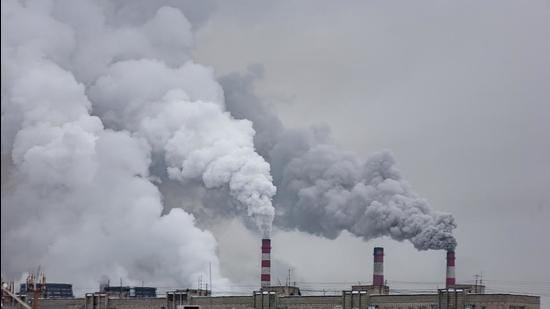Designing a climate law for India
An enabling law that cradles research and prompts investment in green technology might be far more effective in securing India’s long-term economic prosperity than a hastily enacted net-zero or carbon-capping law, which might prove ineffective, unenforceable, or debilitating
The latest Intergovernmental Panel on Climate Change (IPCC) science report asserts more boldly than before the causal relationship between human activity and global warming. All the measurements we have seem to agree that human beings will cross a point of no return before this century’s close — unless, that is, we collectively begin an immediate transition to a low-carbon economy.

In pursuing this transformation, climate legislation will likely play a central role. Around the world, climate laws are emerging as blueprints of national action plans for mitigation and adaptation. Just in 2021, political entities as diverse as Canada and Russia approved laws on the climate crisis.
In a sprawling and unwieldy democracy such as India, a climate law may well be necessary for a coherent effort to meet the challenge. Given India is globally the third highest emitter of CO2, has the potential to avoid locking into high carbon futures, and is severely threatened by rising temperatures, it is time to have a serious conversation about an Indian climate law.
Also Read | Focus on double-dose vaccinations. Boosters can wait
Designing a climate law apt for the Indian political context is a difficult task — it will have to perform a delicate dance between mitigation, adaptation, and development.
There are at present two general visions of climate legislation, globally. The first is a law decreeing a limit on greenhouse gas emissions — most “net-zero” laws in the West articulate such explicit caps. The second focuses less on achieving numerical targets and lays out instead the architecture for a nation’s low-carbon transformation. The carbon-capping law, however, is commonly misunderstood to be the only form that a climate law can assume.
The conventional idea of a carbon-capping law faces three main problems. First, while low-carbon development likely brings economic opportunities, there remain uncertainties and questions about whether hard, time-bound caps might impose development costs, particularly on the poorest.
Second, and closely related, given India’s limited historic contribution to the problem and low per capita emissions, a carbon-capping law, which may be seen as restricting energy choices, is unlikely to win broad political support.
Third, given these considerations, any target set is likely to be relatively modest, and fail to induce transformative change. If, somehow, despite these considerations, an ambitious target is stipulated, it is not clear that, given the peripheral place of climate in Indian politics, it would inspire the requisite large-scale cooperation. Moreover, in the event of failure, liability may be ill-specified to such an extent that courts will be powerless to enforce the desired outcome. Whether the target proves ineffectual or unattainable, we would lose the opportunity to build a robust structure to cope with an uncertain future.
An alternate approach to climate legislation must, therefore, be seriously considered in the Indian context, one that isn’t restricting but enabling of a low-carbon transformation.
Also Read | The Congress isn’t yet out of the seismic zone in Punjab
Broadly speaking, there are three arguments in its favour — effectiveness, efficiency, and prosperity.
An effective law, instead of beginning with deadlines and limits, would first seek to prepare sectors of the economy and government at the national and local levels for a low-carbon transition. By focusing on institutional, technical, and financial capacity building, such a law would attempt to lay the structural foundations for success in mitigation and adaptation.
Large-scale transformations are most likely to succeed when efficient. Economy of motion to a determined goal is best achieved through bottom-up approaches. Rather than the conventional view of global warming as an emergency demanding a decreed halt to proceedings, a climate law can conceptualise the climate crisis as shaping the context for the nation’s developmental path. This can be done by establishing positive feedback loops that mainstream low-carbon growth into state and national roadmaps, strategies, and budgets. By working with the political and economic grain of Indian society, a climate law can optimise, even maximise, its industrial capacity and institutional competence for mitigation and — often ignored in carbon-capping laws — adaption.
The conventional notion of climate laws as carbon-capping instruments has created a strong association in the public imagination of climate legislation with restriction — a species of the spent dichotomy between national prosperity and global responsibility. The rate of global advancement in green transformation, however, shows this dichotomy as false. The international race to sustainability, in energy, building, and transportation, is likely to shift the markers of success in the coming decades. Inaction is thus no longer a neutral or development-positive gesture.
The recent IPCC report signals the urgent need for India, as others, to consider a climate law. However, an enabling law that cradles research and prompts investment in green technology might be far more effective in securing India’s long-term economic prosperity than a hastily enacted net-zero or carbon-capping law, which might prove ineffective, unenforceable, or debilitating. Without a framework mechanism to coordinate strategically India’s low-carbon transition, the body politic risks soon becoming a fossilised remnant of a sooty past.
Anirudh Sridhar is a visiting researcher at the Centre for Policy Research (CPR), New Delhi.
This is the first of a two-part series proposing a new framework for a climate law
The views expressed are personal
Continue reading with HT Premium Subscription




